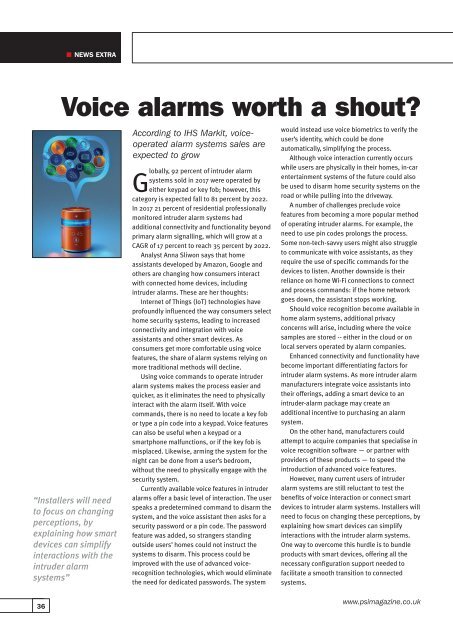PSIJuly2018
Create successful ePaper yourself
Turn your PDF publications into a flip-book with our unique Google optimized e-Paper software.
NEWS EXTRA<br />
Voice alarms worth a shout?<br />
“Installers will need<br />
to focus on changing<br />
perceptions, by<br />
explaining how smart<br />
devices can simplify<br />
interactions with the<br />
intruder alarm<br />
systems”<br />
According to IHS Markit, voiceoperated<br />
alarm systems sales are<br />
expected to grow<br />
lobally, 92 percent of intruder alarm<br />
Gsystems sold in 2017 were operated by<br />
either keypad or key fob; however, this<br />
category is expected fall to 81 percent by 2022.<br />
In 2017 21 percent of residential professionally<br />
monitored intruder alarm systems had<br />
additional connectivity and functionality beyond<br />
primary alarm signalling, which will grow at a<br />
CAGR of 17 percent to reach 35 percent by 2022.<br />
Analyst Anna Sliwon says that home<br />
assistants developed by Amazon, Google and<br />
others are changing how consumers interact<br />
with connected home devices, including<br />
intruder alarms. These are her thoughts:<br />
Internet of Things (IoT) technologies have<br />
profoundly influenced the way consumers select<br />
home security systems, leading to increased<br />
connectivity and integration with voice<br />
assistants and other smart devices. As<br />
consumers get more comfortable using voice<br />
features, the share of alarm systems relying on<br />
more traditional methods will decline.<br />
Using voice commands to operate intruder<br />
alarm systems makes the process easier and<br />
quicker, as it eliminates the need to physically<br />
interact with the alarm itself. With voice<br />
commands, there is no need to locate a key fob<br />
or type a pin code into a keypad. Voice features<br />
can also be useful when a keypad or a<br />
smartphone malfunctions, or if the key fob is<br />
misplaced. Likewise, arming the system for the<br />
night can be done from a user’s bedroom,<br />
without the need to physically engage with the<br />
security system.<br />
Currently available voice features in intruder<br />
alarms offer a basic level of interaction. The user<br />
speaks a predetermined command to disarm the<br />
system, and the voice assistant then asks for a<br />
security password or a pin code. The password<br />
feature was added, so strangers standing<br />
outside users’ homes could not instruct the<br />
systems to disarm. This process could be<br />
improved with the use of advanced voicerecognition<br />
technologies, which would eliminate<br />
the need for dedicated passwords. The system<br />
would instead use voice biometrics to verify the<br />
user’s identity, which could be done<br />
automatically, simplifying the process.<br />
Although voice interaction currently occurs<br />
while users are physically in their homes, in-car<br />
entertainment systems of the future could also<br />
be used to disarm home security systems on the<br />
road or while pulling into the driveway.<br />
A number of challenges preclude voice<br />
features from becoming a more popular method<br />
of operating intruder alarms. For example, the<br />
need to use pin codes prolongs the process.<br />
Some non-tech-savvy users might also struggle<br />
to communicate with voice assistants, as they<br />
require the use of specific commands for the<br />
devices to listen. Another downside is their<br />
reliance on home Wi-Fi connections to connect<br />
and process commands: if the home network<br />
goes down, the assistant stops working.<br />
Should voice recognition become available in<br />
home alarm systems, additional privacy<br />
concerns will arise, including where the voice<br />
samples are stored -- either in the cloud or on<br />
local servers operated by alarm companies.<br />
Enhanced connectivity and functionality have<br />
become important differentiating factors for<br />
intruder alarm systems. As more intruder alarm<br />
manufacturers integrate voice assistants into<br />
their offerings, adding a smart device to an<br />
intruder-alarm package may create an<br />
additional incentive to purchasing an alarm<br />
system.<br />
On the other hand, manufacturers could<br />
attempt to acquire companies that specialise in<br />
voice recognition software — or partner with<br />
providers of these products — to speed the<br />
introduction of advanced voice features.<br />
However, many current users of intruder<br />
alarm systems are still reluctant to test the<br />
benefits of voice interaction or connect smart<br />
devices to intruder alarm systems. Installers will<br />
need to focus on changing these perceptions, by<br />
explaining how smart devices can simplify<br />
interactions with the intruder alarm systems.<br />
One way to overcome this hurdle is to bundle<br />
products with smart devices, offering all the<br />
necessary configuration support needed to<br />
facilitate a smooth transition to connected<br />
systems.<br />
36<br />
www.psimagazine.co.uk

















